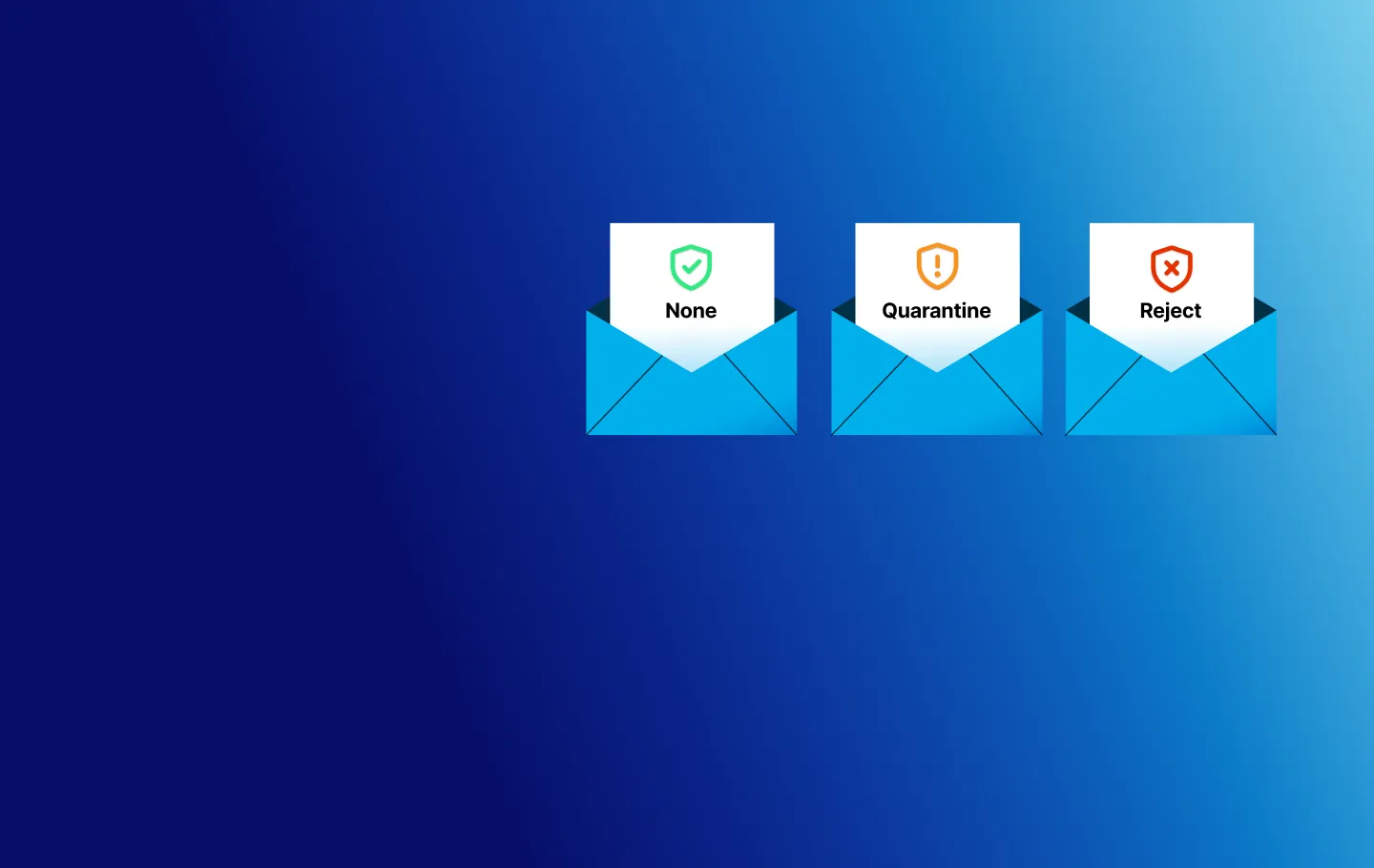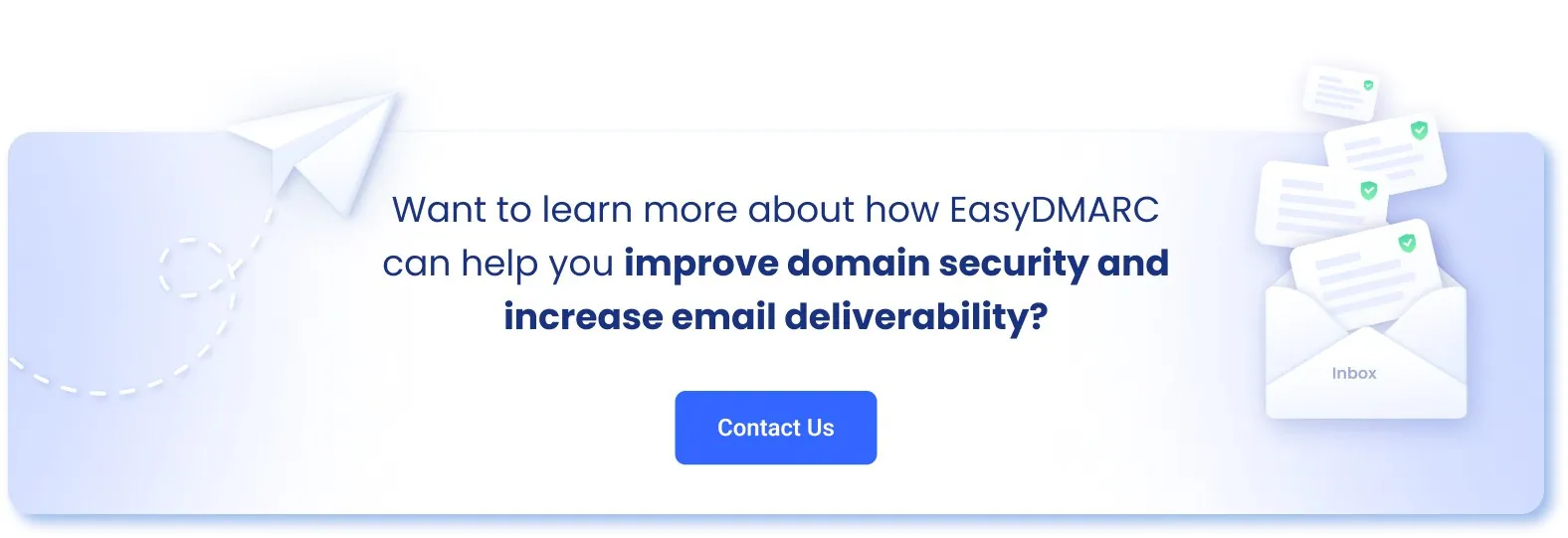Email is one of the most effective communication tools in today’s business world. Every organization uses email to communicate with employees, customers, and business partners, which makes it a common attack vector for cybercriminals.
For that reason, it’s vital to integrate email security best practices into your cybersecurity plan. One of the best ways to protect your email account is to implement and advance your domain’s DMARC policy. The protocol implementation tells the receiver what to do with an email after checking for SPF and DKIM authentication, like whether to accept, quarantine, or reject them.
To implement a DMARC policy, you need to include it in your DMARC record as a DNS TXT record. This article will discuss the three DMARC policies, their importance, and best practices.
DMARC Policy: The Rules of Action
What is a DMARC policy? A DMARC policy allows senders to indicate that their email messages are SPF and DKIM complaints and then tell receivers what to do with unauthenticated emails.
DMARC leverages other security standards to provide an additional layer of security: reporting. When you include a DMARC record in your DNS domain, you can get in-depth knowledge about who is sending emails on your domain’s behalf.
DMARC doesn’t directly address whether or not an email is spam or otherwise fraudulent. Instead, DMARC can require that a message not only pass DKIM or SPF validation but also pass alignment. Under DMARC, a message can fail even if it passes SPF or DKIM but fails alignment.
Setting up DMARC may have a positive impact on deliverability for legitimate senders. With DMARC implementation, you can tell email receivers how to handle email messages that fail authentication and protect your domain from spoofing and other phishing attacks. There are three DMARC policies that you can implement.
{GET STARTED}
Monitoring Policy (p=none)
This is the entry-level policy, where you enter the DMARC record into DNS. the policy marker the record syntax is p. When set to “none” (p=none) DMARC will just monitor your sending sources without taking action.
However, DMARC gives you the opportunity to receive reports by specifying URIs. RUF and RUA DMARC tags serve this purpose in the syntax.
At this stage, unauthorized emails still find their way to the recipient’s inbox folder, but you can use the data to analyze who is sending messages on your domain’s behalf.
This policy is mainly recommended for an organization just starting with DMARC implementation. When you have a good source analysis and data, you can move to the next level of the DMARC policy: Quarantine.
Quarantine Policy (p=quarantine)
The quarantine is the second level of the DMARC policy, adding another function to the previous one. Here, you set the p tag to quarantine (p = quarantine). Besides sending reports, the policy instructs email receiving server to forward messages that failed the authentication DMARC checks to the recipient’s spam folder. Emails that pass the DMARC authentication checks are delivered to the receivers’ inboxes.
At this stage, you can take a gradual approach to hardening your email authentication using the percentage tag (pct), setting it to a specific value that can pass into the inbox.
Reject Policy (p=reject)
This is the third level of the DMARC policy, where you set your p to reject, p=reject. With this configuration, you are telling mail receivers not to deliver messages that fail the authentication checks.
Email messages that pass the checks will be delivered to the receiver’s inbox. This is the best policy for organizations that want to mitigate the impact of email spoofing.
The DMARC reject policy will ensure that all unauthorized emails bypass the receiver’s inbox.
To properly configure your DMARC policy, you need to follow the best practices we’ll discuss in the next section.
DMARC Policy Best Practices
You need to understand the DMARC policy best practices before you start your DMARC implementation journey. Most organizations usually jump straight to reject, and they end up preventing any (both legit and not) messages from getting to the recipient’s inbox.
With the reject policy, the mail receiver will block every message that doesn’t pass the authentication checks. So you need proper monitoring to whitelist or authenticate outgoing email sources. Otherwise, the policy will reject all your important email messages as well.
Start With Monitoring
EasyDMARC’s email experts recommend starting with the ‘P = none” to monitor your domain and gain insight reports on those who are sending messages on your domain’s behalf.
With these reports, you’ll be able to identify legitimate email sources that receivers shouldn’t reject during authentication.
Don’t Skip the Quarantine Policy
Once you’re done configuring your legitimate email sources, you can now escalate your DMARC policy to quarantine. As mentioned above, all the illegitimate emails get sent to the spam folder, while the authenticated ones land in the recipient’s inbox.
Only Move to Reject Policy When You’ve Identified all the Sources
Now that you have marked all your legitimate email sources, you can set your DMARC policy to reject.
The DMARC reject policy will block all unauthenticated email messages from reaching the receiver’s inbox. If you’re considering implementing a DMARC policy, we urge you to follow the best practices below.
What’s Next?
With the rise in email-related cyber attacks, organizations should implement email security best practices to mitigate these risks. DMARC policy is not a thing you can implement overnight.
You can’t enforce a DMARC 100% reject policy because you experience a phishing attack. EasyDMARC discourages instant DMARC reject policy enforcement. Depending on your infrastructure, the DMARC implementation policy can take one to twelve months.
EasyDMARC support team can help you through your DMARC implementation and enforcement journey from start to finish. We’ll ensure that your organization reaches the DMARC reject policy without stress.
Contact us today for help.

